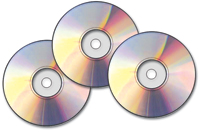|
What is Karaoke?
Karaoke is actually a music entertainment system providing prerecorded accompaniments to popular songs that a performer sings by following the song lyrics on a T.V. screen or video screen. In singing Karaoke, the lead singerís voice is removed, but the background music is still present. If you want to sing a song of Elton John, the Karaoke media would remove Elton Johnís voice and you sing in his place.
Why Karaoke?
What are the different types of Karaoke? Karaoke comes in almost every kind of media such as Karaoke cassette, VHS, laser disk, VCD and DVD. However, some are less practical than others. Normally you don't want to sing every song from the whole Karaoke cassette in a sequence, but you rather want to select a song that you want to sing, for example, the tenth song in the Karaoke cassette. The cassette or VHS Karaoke media are obsolete and cannot offer you the convenience for song selection. Nowadays, with the most advanced technology, our BMB (Better Music Builder) Karaoke amplifier can offer you the digital sound quality, great echo effect and the convenience for song selection by using VCDs and DVDs.
Karaoke System Karaoke System refers to all the component parts of your Karaoke setup. Depending whether it is an all-in-one, home or professional system. A Karaoke system may include the disk player, speakers, mixer, amplifier, stereo, TV, stands, microphones, cables, discs, and accessories.
What is CDG (CD+G/CD+Graphics)?
CD+G discs require a CD+G player in order to display the graphics. A regular CD player can play the audio fine but without the graphics. Most CD+G discs are designed for Karaoke. However, some CDs may have used CD+G to enhance the listening experience by including animated images, pictures and song lyrics. Most computer systems are unable to play CD+G discs because most of the regular CD-ROM drives are unable to read the graphics data area. Therefore, the KMF format was created. This file format was designed to take advantage of the latest audio compression technology, so it can compress the CD+G data and combine them into a single file that most regular computer system can read.
What is Plasma?
|
|
What is LCD?
|
|
What is DLP?
|
|
What is HDTV? HDTV provides pictures with several times the clarity of DVDs and over 5 times the resolution of a regular television picture. HDTV provides vivid color, including a wide range of hues (such as subtle purples and reds) without any bleeding at the edges of the image. HDTV images are as detailed as a high-resolution photograph. It is like looking through a window. When watching a TV program in HD, you will be amazed at the sharpness of the picture. You can even pick up the specks of different colors in an actor's eyes, or see individual sweat drops on a football player--details you could never see through regular television. All HDTV programming can provide 5.1 channel Dolby Digital Surround Sound--just like true theatre sound. HDTV refers to a complete product/system with the following minimum performance attributes:
|
|
What is EDTV? EDTV refers to a complete product/system with the following minimum performance attributes:
|
Audio/Video Education

 Karaoke originated from
Japan. It derived from the word "Kara" meaning "empty hand" as in Karate and the
word "Okesutora" meaning orchestra. Karaoke first appeared for entertainment in
Kobe, Japan in the late 1970's as a way of relieving the stress. It is usually
featured at Karaoke bars, where customers can perform singing on stage by
reading song lyrics on a T.V. screen or video monitor. Karaoke is also a great
way to meet people in Japan. No matter where you may go, you'll find the people
who perform karaoke to be warm and friendly. In the 1980ís, Karaoke came to
America and has been gaining in popularity ever since.
Karaoke originated from
Japan. It derived from the word "Kara" meaning "empty hand" as in Karate and the
word "Okesutora" meaning orchestra. Karaoke first appeared for entertainment in
Kobe, Japan in the late 1970's as a way of relieving the stress. It is usually
featured at Karaoke bars, where customers can perform singing on stage by
reading song lyrics on a T.V. screen or video monitor. Karaoke is also a great
way to meet people in Japan. No matter where you may go, you'll find the people
who perform karaoke to be warm and friendly. In the 1980ís, Karaoke came to
America and has been gaining in popularity ever since.  Almost every kid dreams of being a
pop star one day. Their dream may come true by practicing singing with a
Karaoke. The essential success of Karaoke is just that: you get to the center of
the stage, and you're few minutes of glory in the spotlight. You can always
practice at home to improve your singing with a Karaoke.
Almost every kid dreams of being a
pop star one day. Their dream may come true by practicing singing with a
Karaoke. The essential success of Karaoke is just that: you get to the center of
the stage, and you're few minutes of glory in the spotlight. You can always
practice at home to improve your singing with a Karaoke. CDG, or CD+Graphics, is a standard that was defined to take advantage of the
unused space on a regular CD audio disc. This area is used to hold graphical
data in the form of pictures, text and special instructions to display the data
synchronized to the audio playback. Due to the limitation of computer technology
at the time when it was designed, the graphics are limited to a resolution of
300 x 216 in 16 colors.
CDG, or CD+Graphics, is a standard that was defined to take advantage of the
unused space on a regular CD audio disc. This area is used to hold graphical
data in the form of pictures, text and special instructions to display the data
synchronized to the audio playback. Due to the limitation of computer technology
at the time when it was designed, the graphics are limited to a resolution of
300 x 216 in 16 colors. Plasma Televisions/monitors
apply voltage to any of more than a million tiny chambers filled with neon,
xenon, krypton, or argon, or a combination of these gasses. Using a matrix of
wires to "address" specific chambers, the gasses ionize into plasma that emits
ultraviolet light. Light strikes red, green, or blue phosphors coated on the
inside of the chambers, and a pixel emits that respective colored light.
Plasma Televisions/monitors
apply voltage to any of more than a million tiny chambers filled with neon,
xenon, krypton, or argon, or a combination of these gasses. Using a matrix of
wires to "address" specific chambers, the gasses ionize into plasma that emits
ultraviolet light. Light strikes red, green, or blue phosphors coated on the
inside of the chambers, and a pixel emits that respective colored light.
 LCD (Liquid-crystal display)
televisions work passively, shining a light behind the LCD panel. They include
the same number of pixels as a plasma display, but the pixels are colored red,
green, and blue. When voltage is applied to a pixel, using a matrix of wires,
the pixel becomes dark and light can not show through it.
LCD (Liquid-crystal display)
televisions work passively, shining a light behind the LCD panel. They include
the same number of pixels as a plasma display, but the pixels are colored red,
green, and blue. When voltage is applied to a pixel, using a matrix of wires,
the pixel becomes dark and light can not show through it.  The technology inside DLP is often
referred to as either "micro-mirrors", or DMD. It works this way: build a few
hundred thousand tiny mirrors, and line them up in 800 rows of 600 mirrors each.
Now attach a hinge to each of those 480,000 mirrors. Attach each of those
480,000 hinges to it's own very tiny motor! Power each motor with electrostatic
energy! The motors tilt their mirrors up to 20 degrees at incredible speeds.
This allows the mirrors to modulate light from a lamp, and send the "modulated
signal" out through a lens, on to a screen. The most amazing part of DLP micro
mirrors, is the scale of size. The 480,000 mirrors (actually 580,000 are used),
hinges and motors are packed onto a "wafer" a bit larger than your thumbnail.
The technology inside DLP is often
referred to as either "micro-mirrors", or DMD. It works this way: build a few
hundred thousand tiny mirrors, and line them up in 800 rows of 600 mirrors each.
Now attach a hinge to each of those 480,000 mirrors. Attach each of those
480,000 hinges to it's own very tiny motor! Power each motor with electrostatic
energy! The motors tilt their mirrors up to 20 degrees at incredible speeds.
This allows the mirrors to modulate light from a lamp, and send the "modulated
signal" out through a lens, on to a screen. The most amazing part of DLP micro
mirrors, is the scale of size. The 480,000 mirrors (actually 580,000 are used),
hinges and motors are packed onto a "wafer" a bit larger than your thumbnail.






